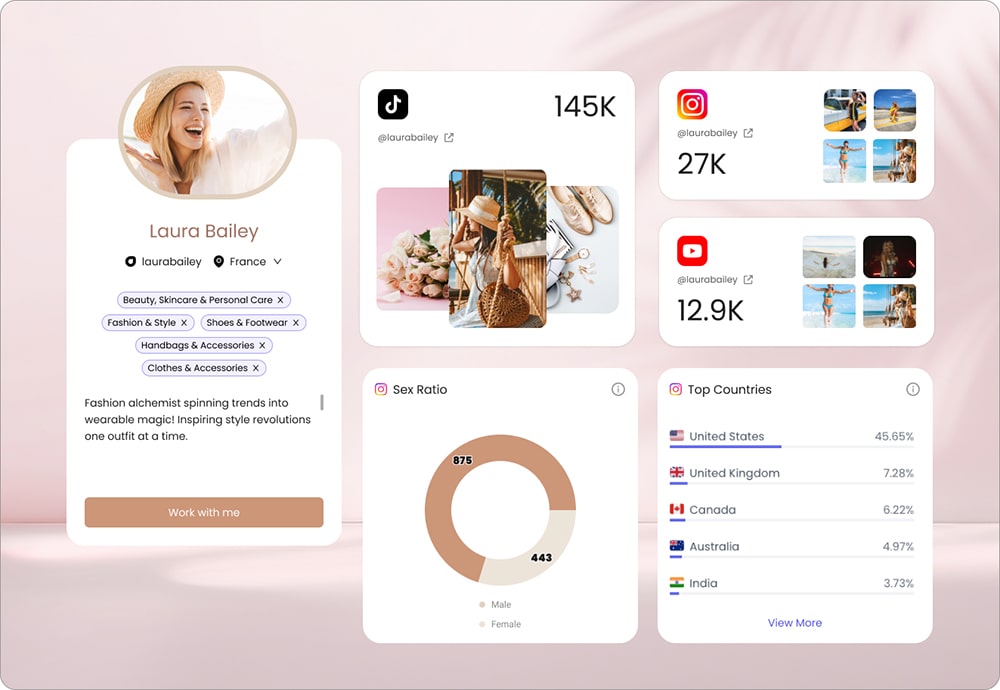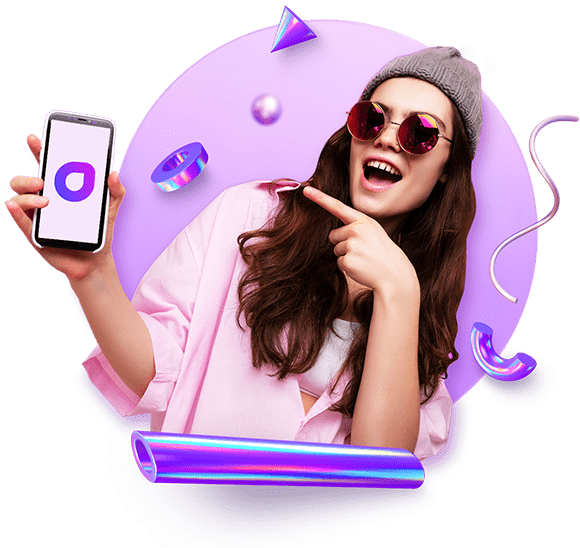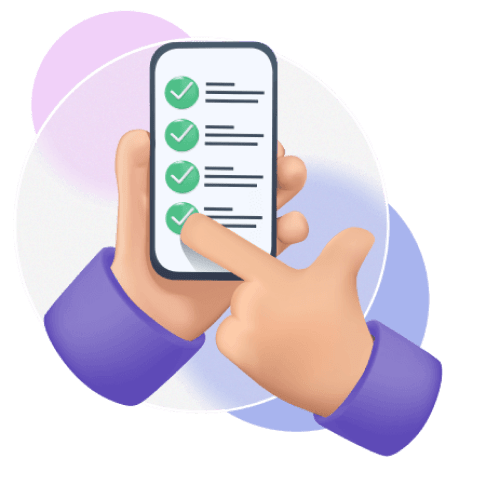- What is a digital creator?
- What does digital creator mean on Instagram?
- How to be a digital creator?
- How do digital creators make money?
- What is an Influencer and what do they do?
- Digital Creators vs. Influencers
- Digital Creators vs. Bloggers
- Digital creator examples
- Renell Medrano capturing moments through a lens
- Conclusion
By now, you’ve probably heard the terms digital creator, influencer, and blogger a few times. But did you know that they are not the same?
In today’s hyper-connected world, a large part of success for a business is knowing how to put themselves in front of new audiences and increase brand awareness. However, for these efforts to be successful, it’s important for brands to know who they are working with, as you’ll need different people for different goals.
In this article, we’ll take a close look at who digital creators, influencers, and bloggers are, what are their similarities and differences, and how each of them can help your brand. Ready? Let’s dive right in.
What is a digital creator?
Generally, a digital creator is someone who creates digital content – videos, photos, animations, podcasts, blog posts, – and shares it across digital platforms. And unlike regular Instagram users doing it for their friends, digital creators consider it to be their career. Digital creators are often referred to as online creators because the content they create is mainly disseminated exclusively through digital platforms. The primary focus of digital creators is to create engaging, fun, informative content, usually with a focus on a specific niche. By doing this, they build an online audience through various channels, such as social platforms, a blog, email newsletters, and others. One important aspect of digital creators is that they can then can use their community to promote their work or collaborate with various brands.
What does digital creator mean on Instagram?
Over the years, Instagram has become a hub for digital creators. The creator-orientedness of the platform is one of the reasons: with the introduction of its digital creator platform, Instagram gave content creators a large variety of tools to create and edit content, target highly-interested people, make guides, share portfolios, see important analytics, and even build mini online stores.
To access all these features and more as a creator to make your work simpler and more attractive, all you need to do is make a creator account or turn your personal page into one. Luckily, it’s very easy. Here’s what you need to do:
- From your profile page and click the three lines in the top right corner.
- Click Settings and select Account.
- Scroll to the bottom and click Switch to a Professional Account, then select Creator.
- If you already have a business account, just choose Switch to Creator Account.
- Select the category that best describes your work.
- Add or edit contact information and choose if or how you want to display it on your profile.
You’re all set! One thing to note, however, is that creator accounts cannot be private. If your personal account is public, it’ll go public after switching to creator mode.
How to be a digital creator?

Being a digital creator is not limited to influencers or individuals, but spreads to brands and companies as well. If your brand is online, creating and sharing content with the aim of building an audience and growing engagement, then congratulations! You are a digital creator. And while you are at it, it’s important that you do it the right way. Here are a few tips to take into consideration as your brand is entering the world of digital content.
Find your niche
It’s impossible to cater to everyone. Brands know this very well, and they identify their target audience very early on. In the digital world, finding your niche is just as important, for several reasons. First of all, it’s very hard to attract a loyal and interested audience if your content is too broad and lacks focus: people will simply be confused as to what your content is about. Secondly, having a specific niche will make the process easier for you, as you’ll know what type of content to concentrate on and avoid spending resources on what won’t work. This way, when you are experiencing a creative block or are unsure what to post, you’ll have a starting point.
Create and be active on social media
As a digital creator, you need to be active on social media. With the abundance of content online, posts don’t have a long shelf life. Therefore, to avoid being forgotten, it’s important that you remain active and consistent. Ideally, you’d have a fixed schedule of posts. This can be difficult in the beginning as you are starting out and still testing to see what works for you.
However, as time goes by, you’ll gain access to analytics and data. Use them to understand what type of content and what frequency works for you. If, for example, the engagement with your posts starts to decrease at around the fifth post per week no matter the post type, you can try posting four times a week and see where it leads you. What’s important is that you continue creating and posting, as it’s what will give you exposure.
Define SMART goals
Another thing you need to do is identify SMART goals for your digital presence. Otherwise, you won’t have a target to measure against and see whether you’ve been successful or not yet.
SMART goals are:
- Specific – Your goals should be specific and well-defined. “Grow my following” isn’t specific, but “Reach 10,000 followers by December is.”
- Measurable – Set goals that can be tracked and measured by numbers. See the example above.
- Achievable – You need to be honest in identifying what you can get done.
- Realistic – Aiming high is good, but you need to be realistic about your resources and capabilities.
- Timely – Have a fixed deadline for achieving each of your goals to stay on track and not lose focus.
SMART goals can serve as a roadmap towards your success as a digital creator, and can significantly help you to succeed in achieving your goal, whatever it may be.
How do digital creators make money?

Now that you know who digital creator is and how they work, let’s take a look at the ways digital creators can earn an income through their online activities.
And because the online world is so versatile, the ways to earn income as a creator are just as many, and there is a right fit for everyone. Here are some of the more popular and working ways in which digital creators can make money.
Affiliate marketing
Affiliate marketing has been there since the first digital platforms came to be, in one form or another. It involves sharing a product in a blog, social media channel, podcast, or any other platform of choice through a unique affiliate link or a code. Every time someone uses that code or link to make a purchase, affiliates earn a commission. Often, the code and the link offer a discount, to further incentivize a purchase. The commission rates will largely depend on the brands and the offer. They can start at 5% and go as high as 50%.
What’s great about affiliate marketing is that it is low risk: there is little involvement on the brand part beyond providing the unique codes. As for digital creators, they can use and promote it at their own pace, without any pressure, often using it as a way to earn passive income.
Their own product line
Another way for digital creators that has earned popularity during the recent few years is a product line in collaboration with a brand.
Often, when a brand-product partnership is successful over a period of time, they decide to work together to create a line of products. This can vary from clothing lines and jewelry to anything else, depending on the niche. As with any other collaboration, it allows both parties to tap into new potential customer bases, earning in the process.
For influencers, the amount of compensation will depend on the agreement and can be percentages from sales or a fixed amount paid upfront.
ViralMango
Most successful content creators make their money from brand partnerships. These types of partnerships are mutually beneficial: if the partnership is a right fit, both brands and influencers get to grow their exposure among interested audiences and earn from the sales. Brand influencer partnerships can range from one-time sponsored posts to brand deals ranging for years and months.
The success of these collaborations, however, largely depends on the initial introduction and subsequent negotiations. This is made significantly simpler by creating a media kit and professionally introducing yourself to the brands. The media kit should encompass your bio, metrics such as engagement rate, follower count, audience demographics, and much more. This will enable you to negotiate higher rates and enhance the creative working process with brands.
What is an Influencer and what do they do?
If you haven’t been living under a rock, you’ve probably heard the term “influencer” once or twice, and may even have an idea of what an influencer is. An influencer is another type of social media personality. Like other types of digital creators, influencers spend a lot of their time online, creating and sharing content. However, the primary aim of the influencer, as the name suggests, is to influence their audience to take an action – follow someone, buy an item, and more.
What makes influencers appealing to marketers and brands is their following: most influencers spend months and even years building a highly curated audience in their niche, who trust the opinions and tastes of the influencer in question. And influencers in their turn usually cooperate only with the brands fitting that niche, as they feel responsible towards their following.
Brands recognize this influence and often approach influencers in their niche for paid promotions and reviews. The majority of the posts of influencers are often brand collaborations, and it’s usually the main way for many influencers to earn their living. And if the collaboration is done successfully, it can greatly benefit both the brand and the influencer, improving sales and ensuring higher exposure for both.
Digital Creators vs. Influencers
If you are confused about the terms about who’s who, you are not alone. With so many social platforms and types of content on them, it’s easy to get lost. To help you with it, let’s take a look at two common terms that often get mixed up, and what each of them means: influencer and digital creators.
Influencers, as we’ve discussed earlier, are people with large social media following and meaningful, trust-based relationships with their audience with an aim to promote and sell products. So, their social media platform is their career, and brand collaborations are their main aim to earn a living.
Now to digital creators. Digital creators create digital content. Simple, isn’t it? Well, almost. In the case of digital creators, the aim of the content may vary significantly: someone looking for paid promotions is a digital creator the same way as a design with a large following sharing their works would be. Instagram, YouTube, and TikTok are large platforms, and there are different types of people there, with different goals, and digital creators can be anyone looking to share information to promote their work to potentially reach new clients, or simply share their passions with likeminded people without expectations of a material gain.
Digital Creators vs. Bloggers

Another term that can get confusing in the age of social media influencers and digital creators is blogger. However, there is a clear difference between a digital creator and a blogger.
As mentioned earlier, the aim of a digital creator is to create content, which will be in the form of images, videos, audio, and articles, and their playground is all of the Internet worlds, from Instagram to YouTube. They can also opt to create content about anything, at any length.
The aim of the blogger, on the other hand, is to write blog posts in a particular niche. Additionally, they are usually limited to one platform, their blog. The blog posts tend to be long-format texts. Another important distinction is that each content piece bloggers put out is planned and considered for the long term, in contrast to digital content with a shorter lifespan. A lot of blogs optimize their content for SEO and expect to drive traffic to their website over a long period of time.
When brands choose to collaborate with bloggers, the content usually differs from the other types of digital content mainly because bloggers will mainly only take on sponsorships they can seamlessly fit into the narrative of their blog.
Digital creator examples
Now that you know the theory, let’s move to the more practical side and “put faces” to the text. Below are a few examples of digital creators you can take a look at to see what exactly they do.
Jackie Aina for cosmetic inclusivity
Jackie Aina is a YouTube creator who’s been actively advocating for the visibility of people of color in the cosmetic industry. Jackie is active both on Instagram as an influencer, and on YouTube as a digital creator.
iJustine and the world of tech
iJustine is a popular digital creator and social media influencer operating in the field of tech. She’s regarded by some as one of the original influencers and has built a big audience of dedicated followers looking to hear all about the latest technological developments from her.
Renell Medrano capturing moments through a lens
Renell Medrano is a visual content creator from New York who started with capturing New Yorkers on camera, then grew to work with large editorials, artists, and brands, and uses Instagram as a portfolio of her works.
Conclusion
The bottom line is, working with digital creators, influencers, and bloggers can be hugely beneficial for your brand, the right choice depends mainly on what your business goals are. If you want to directly promote a product, the influencer may be the right choice. If you want to achieve bigger exposure and improve your marketing collateral without being too salesy, a digital creator may be a better choice. Before you start looking for collaborators for your upcoming marketing campaigns, make sure to define your goals and know exactly what you are looking for. This way you’ll increase your chances of success. Good luck!
Reviewed By Rem Darbinyan
Revolutionizing industries with AI, Rem Darbinyan is the CEO of ViralMango and an entrepreneur, AI expert, and influencer marketing strategist.





